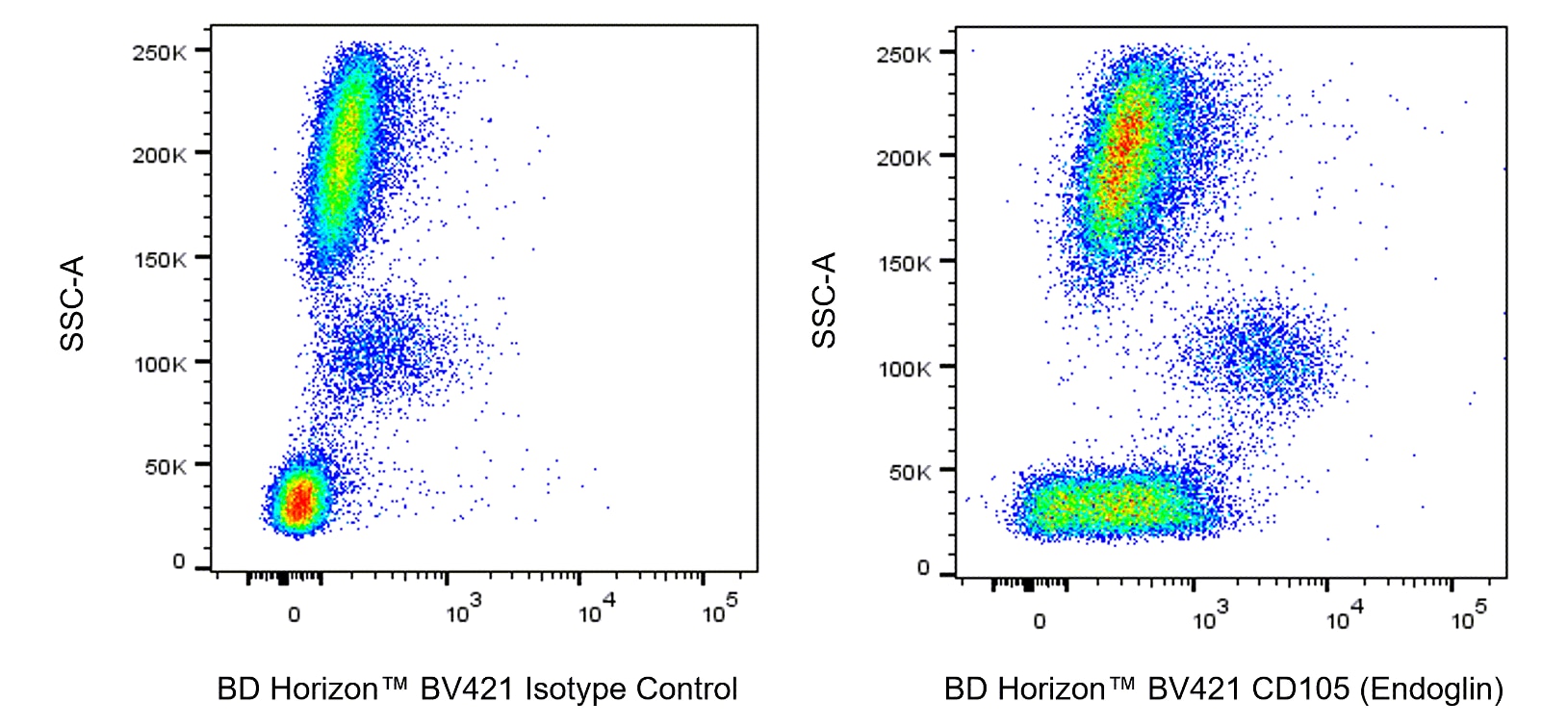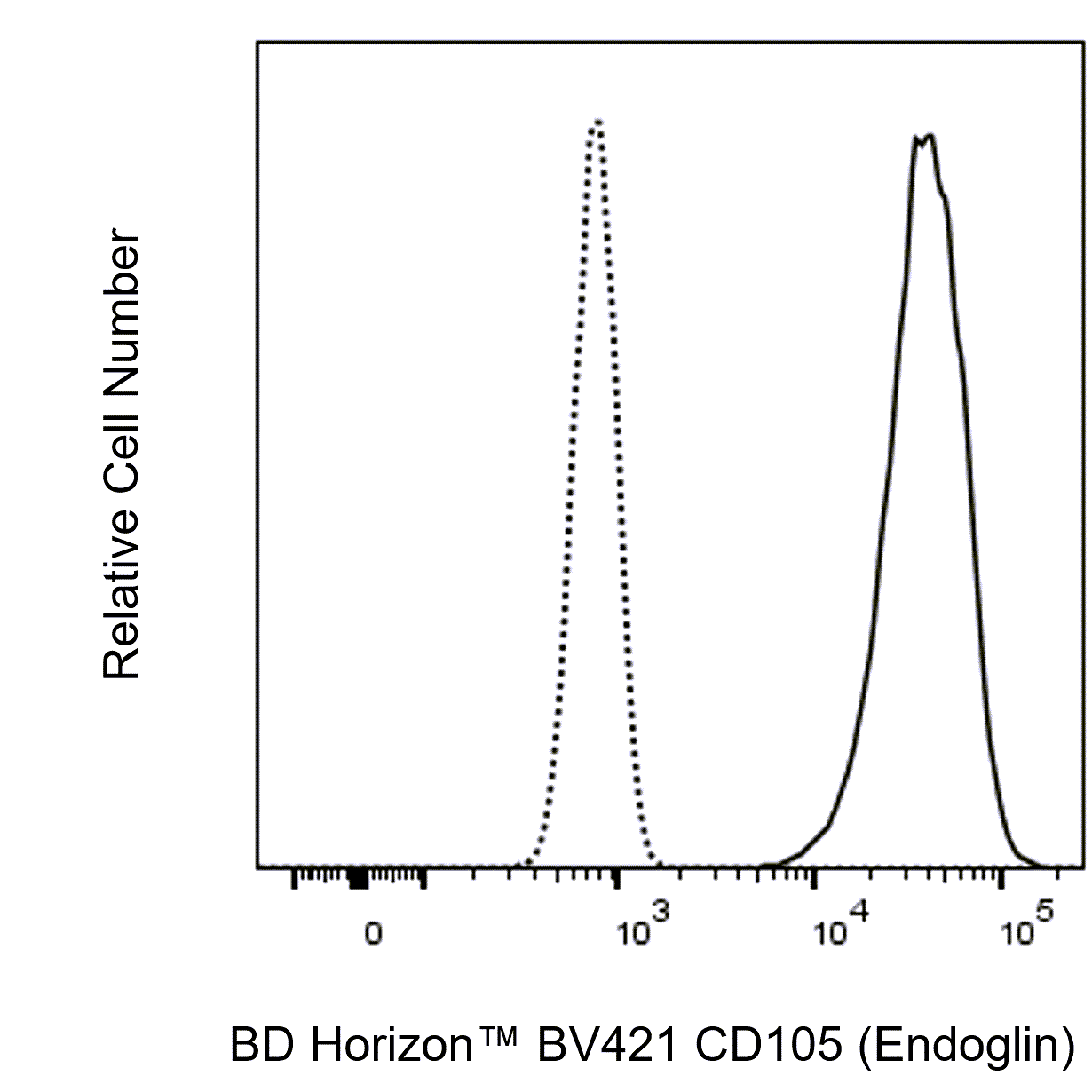Old Browser
This page has been recently translated and is available in French now.
Looks like you're visiting us from {countryName}.
Would you like to stay on the current country site or be switched to your country?






Multiparameter flow cytometric analysis of CD105 (Endoglin) expression on Human peripheral blood leucocyte populations. Human whole blood was stained with either BD Horizon™ BV421 Mouse IgG1, κ Isotype Control (Cat. No. 562438; Left Plot) or BD Horizon™ BV421 Mouse Anti-Human CD105 (Endoglin) antibody (Cat. No. 569032/569033; Right Plot). Erythrocytes were lysed with BD FACS Lysing™ Solution (Cat. No. 349202). The bivariate pseudocolor density plot showing the correlated expression of CD105 (Endoglin) [or Ig Isotype control staining] versus side light-scatter (SSC-A) signals was derived from gated events with the forward and side light-scatter characteristics of intact leucocytes. Flow cytometry and data analysis were performed using a BD LSRFortessa™X-20 Cell Analyzer System and FlowJo™ software.

Flow cytometric analysis of CD105 (Endoglin) expression on Human U-937 cells. Cells from the Human U-937 (Histiocytic lymphoma, ATCC® CRL-1593.2™) cell line were stained with either BD Horizon™ BV421 Mouse IgG1, k Isotype Control (Cat. No. 562438; dashed line histogram) or BD Horizon™ BV421 Mouse Anti-Human CD105 (Endoglin) antibody (Cat. No. 569032/569033; solid line histogram). BD Via-Probe™ Cell Viability 7-AAD Solution (Cat. No. 555815/555816) was added to cells right before analysis. The fluorescence histogram showing CD105 (Endoglin) expression (or Ig Isotype control staining) was derived from gated events with the forward and side light-scatter characteristics of viable (7-AAD-negative) cells. Flow cytometry and data analysis were performed using a BD LSRFortessa™X-20 Cell Analyzer System and FlowJo™ software.


BD Horizon™ BV421 Mouse Anti-Human CD105 (Endoglin)

BD Horizon™ BV421 Mouse Anti-Human CD105 (Endoglin)

Regulatory Status Legend
Any use of products other than the permitted use without the express written authorization of Becton, Dickinson and Company is strictly prohibited.
Preparation And Storage
Recommended Assay Procedures
BD® CompBeads can be used as surrogates to assess fluorescence spillover (compensation). When fluorochrome conjugated antibodies are bound to BD® CompBeads, they have spectral properties very similar to cells. However, for some fluorochromes there can be small differences in spectral emissions compared to cells, resulting in spillover values that differ when compared to biological controls. It is strongly recommended that when using a reagent for the first time, users compare the spillover on cells and BD® CompBeads to ensure that BD® CompBeads are appropriate for your specific cellular application.
For optimal and reproducible results, BD Horizon Brilliant Stain Buffer should be used anytime BD Horizon Brilliant dyes are used in a multicolor flow cytometry panel. Fluorescent dye interactions may cause staining artifacts which may affect data interpretation. The BD Horizon Brilliant Stain Buffer was designed to minimize these interactions. When BD Horizon Brilliant Stain Buffer is used in in the multicolor panel, it should also be used in the corresponding compensation controls for all dyes to achieve the most accurate compensation. For the most accurate compensation, compensation controls created with either cells or beads should be exposed to BD Horizon Brilliant Stain Buffer for the same length of time as the corresponding multicolor panel. More information can be found in the Technical Data Sheet of the BD Horizon Brilliant Stain Buffer (Cat. No. 563794/566349) or the BD Horizon Brilliant Stain Buffer Plus (Cat. No. 566385).
Product Notices
- Please refer to www.bdbiosciences.com/us/s/resources for technical protocols.
- This reagent has been pre-diluted for use at the recommended Volume per Test. We typically use 1 × 10^6 cells in a 100-µl experimental sample (a test).
- An isotype control should be used at the same concentration as the antibody of interest.
- Caution: Sodium azide yields highly toxic hydrazoic acid under acidic conditions. Dilute azide compounds in running water before discarding to avoid accumulation of potentially explosive deposits in plumbing.
- For fluorochrome spectra and suitable instrument settings, please refer to our Multicolor Flow Cytometry web page at www.bdbiosciences.com/colors.
- BD Horizon Brilliant Violet 421 is covered by one or more of the following US patents: 8,158,444; 8,362,193; 8,575,303; 8,354,239.
- BD Horizon Brilliant Stain Buffer is covered by one or more of the following US patents: 8,110,673; 8,158,444; 8,575,303; 8,354,239.
- Human donor specific background has been observed in relation to the presence of anti-polyethylene glycol (PEG) antibodies, developed as a result of certain vaccines containing PEG, including some COVID-19 vaccines. We recommend use of BD Horizon Brilliant™ Stain Buffer in your experiments to help mitigate potential background. For more information visit https://www.bdbiosciences.com/en-us/support/product-notices.
- Please refer to http://regdocs.bd.com to access safety data sheets (SDS).
- For U.S. patents that may apply, see bd.com/patents.
Companion Products





The SN6h monoclonal antibody specifically recognizes CD105. CD105 is a type I transmembrane glycoprotein that is encoded by END (Endoglin) and belongs to the transforming growth factor-β (TGF-β) type III receptor family. CD105 (Endoglin) is expressed on cells as a homodimer comprised of ~95 kDa subunits. It is expressed on vascular endothelial cells and placental syncytiotrophoblasts and at lower levels on stromal fibroblasts. CD105 (Endoglin) is also expressed on mesenchymal stem cells, erythroid precursors, monocytes, macrophages, pre-B cells, and some tumor cells and cell lines including U937 cells. CD105 (Endoglin) serves as a regulatory component of the TGF-β receptor system. In association with TGF- βRI or TGF- βRII, CD105 (Endoglin) binds TGF-β1 and TGF-β3 with high affinity but does not bind to TGF-β2. Expression of CD105 (Endoglin) is increased on activated endothelium in tissues undergoing angiogenesis, such as in tumors, or in cases of wound healing or dermal inflammation.

Development References (5)
-
Mutin M, Dignat-George F, Sampol J. Immunologic phenotype of cultured endothelial cells: quantitative analysis of cell surface molecules.. Tissue Antigens. 1997; 50(5):449-58. (Clone-specific: Flow cytometry). View Reference
-
Schoonderwoerd MJA, Goumans MTH, Hawinkels L. Endoglin: Beyond the Endothelium. Biomolecules. 2020; 10:1-17. (Biology). View Reference
-
Seon BK, Matsuno F, Haruta Y, Barcos M, Spaulding B. CD105 Workshop: immunohistochemical detection of CD105 in the vascular endothelium of human malignant and non-malignant tissues. In: Kishimoto T. Tadamitsu Kishimoto .. et al., ed. Leucocyte typing VI : white cell differentiation antigens : proceedings of the sixth international workshop and conference held in Kobe, Japan, 10-14 November 1996. New York: Garland Pub.; 1997:709–710.
-
She X, Matsuno F, Harada N, Tsai H, Seon BK. Synergy between anti-endoglin (CD105) monoclonal antibodies and TGF-beta in suppression of growth of human endothelial cells.. Int J Cancer. 2004; 108(2):251-7. (Immunogen: Immunoprecipitation, Radioimmunoassay). View Reference
-
Takahashi N, Kawanishi-Tabata R, Haba A, et al. Association of serum endoglin with metastasis in patients with colorectal, breast, and other solid tumors, and suppressive effect of chemotherapy on the serum endoglin.. Clin Cancer Res. 2001; 7(3):524-32. (Clone-specific: Flow cytometry). View Reference
Please refer to Support Documents for Quality Certificates
Global - Refer to manufacturer's instructions for use and related User Manuals and Technical data sheets before using this products as described
Comparisons, where applicable, are made against older BD Technology, manual methods or are general performance claims. Comparisons are not made against non-BD technologies, unless otherwise noted.
For Research Use Only. Not for use in diagnostic or therapeutic procedures.